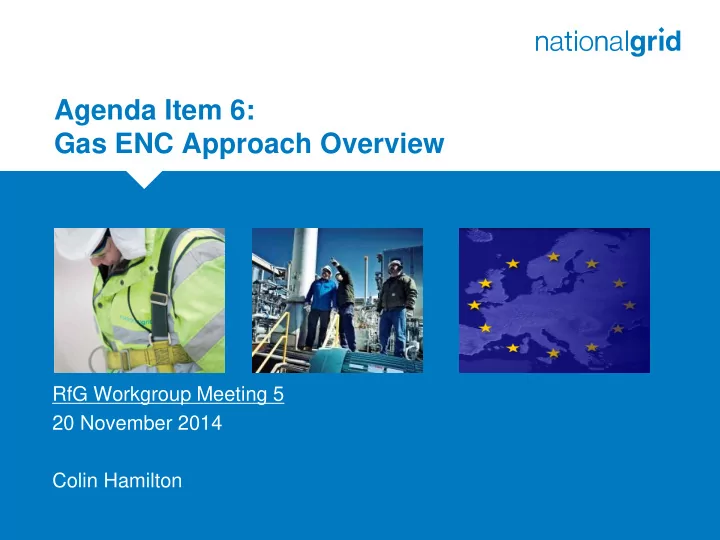

Agenda Item 6: Gas ENC Approach Overview Place your chosen image here. The four corners must just cover the arrow tips. For covers, the three pictures should be the same size and in a straight line. RfG Workgroup Meeting 5 20 November 2014 Colin Hamilton
NG NTS Approach for Engagement Dedicated NG workshops were held to lay out the implications of the 3 rd package and outline code concepts & developments. Led to: Ofgem/DECC EU Stakeholder Group Concept of a dedicated JESG type group was considered. Consensus view was that existing updates within existing Transmission WG were sufficient. Standing agenda item for the past 3 years 2
NG NTS Approach for Engagement European WG created January 2014 Separate group required to allow fullest industry involvement Consideration of all issues affecting UNC Held same day as monthly Transmission WG Additional EU WG meetings now occur for detailed consideration of each Code. 3
EU Updates to GB Stakeholders Regular updates are provided by NG NTS to GB stakeholders via DECC/OFGEM stakeholder meetings, Transmission/EU Workgroup Updates (monthly), Industry Fora (where requested), NG open meetings (ad hoc), Bilateral meetings, etc. The updates have covered the following: Development of the European Framework Guidelines or Code – highlighting emerging concepts, rules, encouraging involvement in and detailing EU engagement opportunities, phase completion dates and implementation dates National Grid Impact Assessments (IAs) – highlighting areas of change for GB regime Comitology Updates – highlighting changes made by the EC following discussion with member states Pre Modification Updates – providing further detail on the changes identified and/or how they maybe implemented Details on high level implementation roadmap are communicated
Additional support for stakeholders NG Web page created Dedicated web page to provide a comprehensive resource for all EU code implementation issues. Future updates….. Code mod proposals….
Programme Road Map showing Phased Implementation Notes: 1) Short term UIOLI may not be required for NTS 2) Long term capacity auctions may need to be delivered in conjunction with short term auctions
Coordination with neighbours In order to facilitate the implementation of the EU regulations on CAM at GB IPs, the Regulators requested that the adjacent TSOs develop a ‘Concept Document’ Concept document aimed to outline the key principles all the TSOs need to adopt in order for the EU Codes to be successfully implemented Therefore an element of parallel working is required….. How NRAs coordinate has also to be considered. This process has facilitated dialogue between connected parties
Approach to UNC Modification Plans for Phase 2 Phase 2 of programme required the implementation of several codes NG NTS provided initial views on the number and types of Mods required to deliver the phase 2 changes Stakeholder views were sought on these initial plans NG NTS considered whether to develop a series of mods or one “super mod”
Approach to UNC Modification Plans for Phase 2 One “super” modification ensures coordinated implementation and coherent legal text change NG NTS concluded that it was not appropriate to raise one “super” Mod, as this was likely to be very complex and delay timelines Proposal that it was easier and more flexible to develop several modifications Requires some degree of parallel working Risks arise if some changes are approved and others delayed Legal text must be individually implementable Industry was asked to respond on this approach
Approach to UNC Modification Plans for Phase 2 Stakeholder feedback supported the multiple modification approach Each Code Lead was tasked to indicated how best to implement their respective code – whether this be 1 Mod or a Mod per area of change Stakeholders consulted on approach Modifications proposed to go to Workgroup for development/discussion with UNC parties and not straight to consultation Small proposals should take up to 6 months to develop Larger proposals could take around 6-9 months to develop
Phase 2 UNC Modifications Potential Timescales EU Network Code Area of change Panel Submission Workgroup UNC Development Consultation Gas Balancing (BAL) Information Provision March 2014 2 Months July 2014 Nomination Process at IP’s April 2014 6 - 9 Months Nov 2014 Capacity Allocation CAM / CMP Compliant May 2014 6 - 9 Months Q4 - 2014 (CAM) Capacity Auctions Interoperability & OBAs / allocations August 2014 6 Months Q1 - 2015 Data Exchange (INT) Interconnection Q1 - 2015 3 Months Q2 - 2015 Agreements/Contract Changes (facilitating Modification ) Ancillary Agreements December 2014 3 Months Q2 - 2015 Units (reference conditions) November 2014 3 months Q1 - 2015
Recommend
More recommend